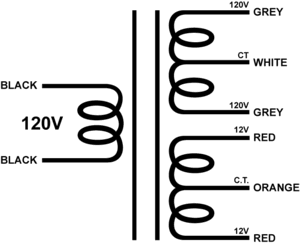"...to alleviate current and voltage imbalances when many power tubes were hooked in parallel."
Wire twisting will also work when tubes are connected in series, however,
care must always be taken to ensure that current not only flows in opposite directions,
but also that it is balanced in strength.
This is actually easier with series circuits, since the current is the same in every part of the circuit.
All this effort will only eliminate some of the heater-hum:
Other leaks will occur inside the tubes in the form of leakage currents between heater and cathode, unless steps are taken to float the D.C. offset voltage appropriately in relation to the D.C. on the cathode.
One way to minimize hum from heater-leakage is to use a 12.6v center-tapped winding for heaters and connect the center-tap to ground. This in theory balances the hum signal.

In the example below, we can see this technique:

It may be more difficult to do this with 6.3 windings that don't have a center-tap. In that case, you can make your own Center-Tap (c.t.) by using a high resistance resistor divider:
Typically, a power-amp heater circuit draws over 2 amps (.9 to 1.6 amps per tube). Ohm's Law says the heater circuit must be less than 3 ohms! We can add a divider with 1k ohm resistors (or higher) with no effect on the load at all, and connect the center to ground.
The idea here is to use as low a resistor as practical to lower random resistor-noise too.
Particularly with large Directly Heated Cathode tubes (where cathode and heater are the same object), the idea is to 'balance' the hum coming from each end of the large heater/cathode (the resistance across the heater causes the voltage to differ at each end during maximum voltage swing of the heater transformer).
Below, an adjustment has been built into the circuit to minimize hum. The extra resistors ensure an approximate balance is maintained even if the pot wiper opens its circuit,
and the caps take out any transient spikes and HF noise as well.
The circuit is grounded through a resistor to prevent any current flow and/or interference with other grounded circuits.

This arrangement would work equally well with a circuit that
is floated at some D.C. value by connection to a voltage rather than ground, provided that this high-current source
cannot interact with the D.C. source in an undesirable manner.
Some designers refuse to convert A.C. to D.C. for these tubes,
because they fear uneven wear on the cathodes from chronic voltage differences
at each end of the heater inside.
But that worry can simply be alleviated with a polarity switch,
which is periodically toggled to even up the strain on the tubes.
Why have hum when you don't have to?
A power supply regulator and caps cannot stop an antenna arrangement from being one. But it will block and absorb transmission and effectively completely alter and destroy the function of it. Any 'antenna' effects still coming in on the heater lines would have to enter through the open bottom (or top) of a 3/4 closure like a guitar amp chassis. The final cure is to install a finishing plate, which should have been provided by the maker. |

No comments:
Post a Comment